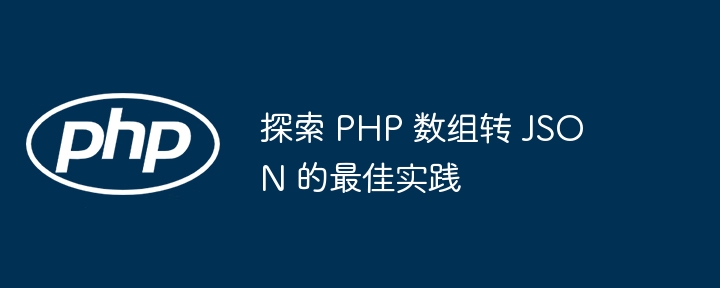Explore best practices for converting PHP arrays to JSON
Best practices for converting arrays to JSON in PHP include using the json_encode() function, which accepts useful options (such as formatting, escaping control); directly building a JSON string provides more flexible customization; Adjust option settings based on array size and complexity.

Explore the best practices for converting PHP arrays to JSON
In PHP, converting arrays to JSON strings is a common task. There are a variety of ways to accomplish this, but some are better than others depending on your specific needs.
json_encode() function
json_encode() function is the default method for converting PHP arrays to JSON. It is simple and easy to use, only accepts array parameters and returns a JSON string.
<?php
$array = ['name' => 'John', 'age' => 30];
$json = json_encode($array);
echo $json; // 输出: {"name":"John","age":30}
?>Commonly used options
json_encode() Accepts several useful options to customize the JSON output:
- JSON_PRETTY_PRINT: Format JSON in a readable format.
- JSON_UNESCAPED_SLASHES: Do not escape backslash characters.
- JSON_UNESCAPED_UNICODE: Do not escape Unicode characters.
Practical Case
Consider an array that stores customer data:
<?php
$customers = [
['name' => 'Alice', 'email' => 'alice@example.com'],
['name' => 'Bob', 'email' => 'bob@example.com']
];
?>To convert this array to JSON, you can use json_encode():
<?php
$json = json_encode($customers);
echo $json; // 输出: [{"name":"Alice","email":"alice@example.com"},{"name":"Bob","email":"bob@example.com"}]
?>Custom encoding
If you want more control over the JSON output, you can build the JSON string directly. This allows for more flexible customization than json_encode().
<?php
$json = '{"customers": [';
foreach ($customers as $customer) {
$json .= '{"name": "' . $customer['name'] . '", "email": "' . $customer['email'] . '"},';
}
$json = rtrim($json, ',') . ']}';
echo $json; // 输出: {"customers": [{"name":"Alice","email":"alice@example.com"},{"name":"Bob","email":"bob@example.com"}]}
?>Choose the best method
Choosing the best method to convert an array to JSON depends on your needs:
- If you Need a simple, out-of-the-box solution,
json_encode()is a good choice. - If you require more advanced customization, consider building the JSON string directly.
- Adjust option settings based on array size and complexity.
The above is the detailed content of Explore best practices for converting PHP arrays to JSON. For more information, please follow other related articles on the PHP Chinese website!

Hot AI Tools

Undresser.AI Undress
AI-powered app for creating realistic nude photos

AI Clothes Remover
Online AI tool for removing clothes from photos.

Undress AI Tool
Undress images for free

Clothoff.io
AI clothes remover

AI Hentai Generator
Generate AI Hentai for free.

Hot Article

Hot Tools

Notepad++7.3.1
Easy-to-use and free code editor

SublimeText3 Chinese version
Chinese version, very easy to use

Zend Studio 13.0.1
Powerful PHP integrated development environment

Dreamweaver CS6
Visual web development tools

SublimeText3 Mac version
God-level code editing software (SublimeText3)

Hot Topics
 1371
1371
 52
52
 PHP 8.4 Installation and Upgrade guide for Ubuntu and Debian
Dec 24, 2024 pm 04:42 PM
PHP 8.4 Installation and Upgrade guide for Ubuntu and Debian
Dec 24, 2024 pm 04:42 PM
PHP 8.4 brings several new features, security improvements, and performance improvements with healthy amounts of feature deprecations and removals. This guide explains how to install PHP 8.4 or upgrade to PHP 8.4 on Ubuntu, Debian, or their derivati
 CakePHP Working with Database
Sep 10, 2024 pm 05:25 PM
CakePHP Working with Database
Sep 10, 2024 pm 05:25 PM
Working with database in CakePHP is very easy. We will understand the CRUD (Create, Read, Update, Delete) operations in this chapter.
 CakePHP Date and Time
Sep 10, 2024 pm 05:27 PM
CakePHP Date and Time
Sep 10, 2024 pm 05:27 PM
To work with date and time in cakephp4, we are going to make use of the available FrozenTime class.
 CakePHP File upload
Sep 10, 2024 pm 05:27 PM
CakePHP File upload
Sep 10, 2024 pm 05:27 PM
To work on file upload we are going to use the form helper. Here, is an example for file upload.
 CakePHP Routing
Sep 10, 2024 pm 05:25 PM
CakePHP Routing
Sep 10, 2024 pm 05:25 PM
In this chapter, we are going to learn the following topics related to routing ?
 Discuss CakePHP
Sep 10, 2024 pm 05:28 PM
Discuss CakePHP
Sep 10, 2024 pm 05:28 PM
CakePHP is an open-source framework for PHP. It is intended to make developing, deploying and maintaining applications much easier. CakePHP is based on a MVC-like architecture that is both powerful and easy to grasp. Models, Views, and Controllers gu
 CakePHP Creating Validators
Sep 10, 2024 pm 05:26 PM
CakePHP Creating Validators
Sep 10, 2024 pm 05:26 PM
Validator can be created by adding the following two lines in the controller.
 How To Set Up Visual Studio Code (VS Code) for PHP Development
Dec 20, 2024 am 11:31 AM
How To Set Up Visual Studio Code (VS Code) for PHP Development
Dec 20, 2024 am 11:31 AM
Visual Studio Code, also known as VS Code, is a free source code editor — or integrated development environment (IDE) — available for all major operating systems. With a large collection of extensions for many programming languages, VS Code can be c




